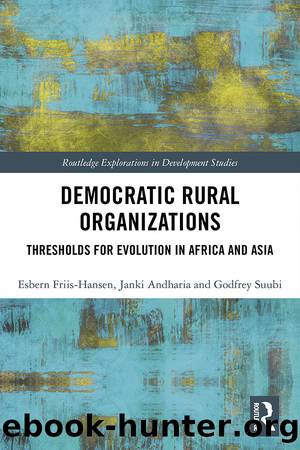Democratic Rural Organizations by unknow

Author:unknow
Language: eng
Format: epub
Tags: Social Science, Developing & Emerging Countries, Sociology, Rural
ISBN: 9781315473635
Google: DitEDwAAQBAJ
Publisher: Routledge
Published: 2017-12-22T03:33:12+00:00
Inequalities may increase within groups, thus widening intra-group poverty gaps and acting as a destabilizing force. Since individuals are differently endowed with natural resources, levels of economic activities, land values, etc., some individuals will generate more income than others and can afford greater access to services than other members in the same group. It is sometimes argued that the available resources need to be equally distributed during group formation. However, others recognize that mixing the well-off and poorer farmers in the same groups can sometimes create development dynamics, which can benefit all group members, as illustrated by the Caritas-supported DROs in Uganda. At the same time, the potentially destabilizing effect of very wide disparities between individuals cannot be overlooked. It is imperative in the process of DRO formation to put in place mechanisms and provisions that limit the ability of individual elites to dominate the group, as in the case of the treasurer of the Katikamu CAPCA Farmersâ Association.
A common argument in support of DROs is that they can achieve economies of scale. Central to this argument is that input and output marketing transaction costs for small-scale farmers can be reduced when they collaborate in DROs. DRO formation should ideally allow each individual member to undertake such steps as they see fit and to benefit from them while ensuring that mechanisms are in place to protect against elite capture and corruption. Assertions of increased efficiency and cost savings associated with establishing a DRO sometimes prove incorrect, as factors such as coordinating the DROâs activities, the remoteness of the DRO and its lack of capacity to invest in actions relevant to local situations all lead to higher costs, which may offset any savings that have been realized. This has been demonstrated in DROs that invested value-adding equipment and required to be jointly financed. In addition, free-riding by some individuals may emerge, which also comes at a cost.
There are nonetheless circumstances in which DROs will lead to higher levels of efficiency. The ideal approach may be to identify those aspects of any activity which could benefit from collaboration, such as bulking both purchasing and selling, and then differentiate them from those aspects that are related to more efficient management at the individual level.
DROs create the potential for conflict between the immediate needs of the individual members and the DROâs long-term interests. As all DRO members are likely to have many immediate and pressing needs, conflicts of interest between individual members and the DRO are very likely to emerge. Such differences in interests are not necessarily negative for the DRO: depending on how such conflicts are reduced by DRO leaders, they can stimulate collective action that is beneficial to all members. Still, if not appropriately managed, such conflicts can undermine the membersâ trust in their own organization.
Download
This site does not store any files on its server. We only index and link to content provided by other sites. Please contact the content providers to delete copyright contents if any and email us, we'll remove relevant links or contents immediately.
The Lonely City by Olivia Laing(4768)
Animal Frequency by Melissa Alvarez(4424)
All Creatures Great and Small by James Herriot(4266)
Walking by Henry David Thoreau(3921)
Exit West by Mohsin Hamid(3791)
Origin Story: A Big History of Everything by David Christian(3665)
COSMOS by Carl Sagan(3584)
How to Read Water: Clues and Patterns from Puddles to the Sea (Natural Navigation) by Tristan Gooley(3430)
Hedgerow by John Wright(3313)
How to Read Nature by Tristan Gooley(3289)
The Inner Life of Animals by Peter Wohlleben(3282)
How to Do Nothing by Jenny Odell(3263)
Project Animal Farm: An Accidental Journey into the Secret World of Farming and the Truth About Our Food by Sonia Faruqi(3188)
Origin Story by David Christian(3169)
Water by Ian Miller(3153)
A Forest Journey by John Perlin(3042)
The Plant Messiah by Carlos Magdalena(2899)
A Wilder Time by William E. Glassley(2833)
Forests: A Very Short Introduction by Jaboury Ghazoul(2814)
